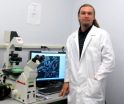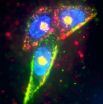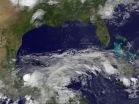(Press-News.org) (Santa Barbara, Calif.) — Scientists at UC Santa Barbara have designed a nanoparticle that has a couple of unique — and important — properties. Spherical in shape and silver in composition, it is encased in a shell coated with a peptide that enables it to target tumor cells. What's more, the shell is etchable so those nanoparticles that don't hit their target can be broken down and eliminated. The research findings appear today in the journal Nature Materials.
The core of the nanoparticle employs a phenomenon called plasmonics. In plasmonics, nanostructured metals such as gold and silver resonate in light and concentrate the electromagnetic field near the surface. In this way, fluorescent dyes are enhanced, appearing about tenfold brighter than their natural state when no metal is present. When the core is etched, the enhancement goes away and the particle becomes dim.
UCSB's Ruoslahti Research Laboratory also developed a simple etching technique using biocompatible chemicals to rapidly disassemble and remove the silver nanoparticles outside living cells. This method leaves only the intact nanoparticles for imaging or quantification, thus revealing which cells have been targeted and how much each cell internalized.
"The disassembly is an interesting concept for creating drugs that respond to a certain stimulus," said Gary Braun, a postdoctoral associate in the Ruoslahti Lab in the Department of Molecular, Cellular and Developmental Biology (MCDB). "It also minimizes the off-target toxicity by breaking down the excess nanoparticles so they can then be cleared through the kidneys."
This method for removing nanoparticles unable to penetrate target cells is unique. "By focusing on the nanoparticles that actually got into cells," Braun said, "we can then understand which cells were targeted and study the tissue transport pathways in more detail."
Some drugs are able to pass through the cell membrane on their own, but many drugs, especially RNA and DNA genetic drugs, are charged molecules that are blocked by the membrane. These drugs must be taken in through endocytosis, the process by which cells absorb molecules by engulfing them.
"This typically requires a nanoparticle carrier to protect the drug and carry it into the cell," Braun said. "And that's what we measured: the internalization of a carrier via endocytosis."
Because the nanoparticle has a core shell structure, the researchers can vary its exterior coating and compare the efficiency of tumor targeting and internalization. Switching out the surface agent enables the targeting of different diseases — or organisms in the case of bacteria — through the use of different target receptors. According to Braun, this should turn into a way to optimize drug delivery where the core is a drug-containing vehicle.
"These new nanoparticles have some remarkable properties that have already proven useful as a tool in our work that relates to targeted drug delivery into tumors," said Erkki Ruoslahti, adjunct distinguished professor in UCSB's Center for Nanomedicine and MCDB department. "They also have potential applications in combating infections. Dangerous infections caused by bacteria that are resistant to all antibiotics are getting more common, and new approaches to deal with this problem are desperately needed. Silver is a locally used antibacterial agent and our targeting technology may make it possible to use silver nanoparticles in treating infections anywhere in the body."
INFORMATION: END
Targeting tumors using silver nanoparticles
A new platform developed at UCSB increases the efficiency of drug delivery and allows excess particles to be washed away
2014-06-08
ELSE PRESS RELEASES FROM THIS DATE:
Quick getaway: How flies escape looming predators
2014-06-08
When a fruit fly detects an approaching predator, it takes just a fraction of a second to launch itself into the air and soar gracefully to safety—but there's not always time for that. Some threats demand a quicker getaway, even if things get a little clumsy. New research from scientists at the Howard Hughes Medical Institute's Janelia Research Campus reveals how a quick-escape circuit in the fly's brain overrides the fly's slower, more controlled behavior when a threat becomes urgent.
"The fly's rapid takeoff is, on average, eight milliseconds faster than its more controlled ...
More than just a hill of beans: Phaseolus genome lends insights into nitrogen fixation
2014-06-08
"It doesn't take much to see that the problems of three little people doesn't add up to a hill of beans in this crazy world," Humphrey Bogart famously said in the movie Casablanca. For the farmers and breeders around the world growing the common bean, however, ensuring that there is an abundant supply of this legume is crucial, both for its importance in cropping systems to ensure plant vitality and for food security. Moreover, the U.S. Department of Energy Office of Science has targeted research into the common bean because of its importance in enhancing nitrogen use ...
Argument with dad? Find friendly ears to talk it out, study shows
2014-06-06
With Father's Day approaching, SF State's Jeff Cookston has some advice for creating better harmony with dad. In a recent study, he found that when an adolescent is having an argument with their father and seeks out others for help, the response he or she receives is linked to better well-being and father-child relationships.
Adolescents who receive an reason for the father's behavior or a better understanding of who is at fault feel better about themselves and about dad as well. Those feelings about dad, in turn, are linked to a lower risk of depression for youth.
The ...
Scientists reveal details of calcium 'safety-valve' in cells
2014-06-06
UPTON, NY -- Sometimes a cell has to die-when it's done with its job or inflicted with injury that could otherwise harm an organism. Conversely, cells that refuse to die when expected can lead to cancer. So scientists interested in fighting cancer have been keenly interested in learning the details of "programmed cell death." They want to understand what happens when this process goes awry and identify new targets for anticancer drugs.
The details of one such target have just been identified by a group of scientists from the U.S. Department of Energy's Brookhaven National ...
Brain traffic jams that can disappear in 30 seconds
2014-06-06
BUFFALO, N.Y. – Motorists in Los Angeles, San Francisco and other gridlocked cities could learn something from the fruit fly.
Scientists have found that cellular blockages, the molecular equivalent to traffic jams, in nerve cells of the insect's brain can form and dissolve in 30 seconds or less.
The findings, presented in the journal PLOS ONE, could provide scientists much-needed clues to better identify and treat neurodegenerative diseases such as Alzheimer's and Huntington's.
"Our research suggests that fixed, permanent blocks may impede the transport of important ...
LSU biologist John Caprio, Japanese colleagues identify unique way catfish locate prey
2014-06-06
BATON ROUGE – Animals incorporate a number of unique methods for detecting prey, but for the Japanese sea catfish, Plotosus japonicus, it is especially tricky given the dark murky waters where it resides.
John Caprio, George C. Kent Professor of Biological Sciences at LSU, and colleagues from Kagoshima University in Japan have identified that these fish are equipped with sensors that can locate prey by detecting slight changes in the water's pH level.
A paper, "Marine teleost locates live prey through pH sensing," detailing the work of Caprio and his research partners, ...
Better tissue healing with disappearing hydrogels
2014-06-06
When stem cells are used to regenerate bone tissue, many wind up migrating away from the repair site, which disrupts the healing process. But a technique employed by a University of Rochester research team keeps the stem cells in place, resulting in faster and better tissue regeneration. The key, as explained in a paper published in Acta Biomaterialia, is encasing the stem cells in polymers that attract water and disappear when their work is done.
The technique is similar to what has already been used to repair other types of tissue, including cartilage, but had never ...
Lower asthma risk is associated with microbes in infants' homes
2014-06-06
Infants exposed to a diverse range of bacterial species in house dust during the first year of life appear to be less likely to develop asthma in early childhood, according to a new study published online on June 6, 2014, in the Journal of Allergy and Clinical Immunology.
Children who were neither allergic nor prone to wheezing as three-year-olds were the most likely to have been exposed to high levels of bacteria, and paradoxically, to high levels of common allergens.
In fact, some of the protective bacteria are abundant in cockroaches and mice, the source of these ...
NASA and NOAA satellites eyeing Mexico's tropical soaker for development
2014-06-06
NASA and NOAA satellites are gathering visible, infrared, microwave and radar data on a persistent tropical low pressure area in the southwestern Bay of Campeche. System 90L now has a 50 percent chance for development, according to the National Hurricane Center and continues to drop large amounts of rainfall over southeastern Mexico.
The Atmospheric Infrared Sounder (AIRS) instrument aboard NASA's Aqua satellite gathered infrared data on the developing low on June 5 at 18:59 UTC (2:59 p.m. EDT).
Basically, AIRS looks at the infrared region of the spectrum. In a spectrum, ...
Study shows health policy researchers lack confidence in social media for communication
2014-06-06
Philadelphia – Though Twitter boats 645 million users across the world, only 14 percent of health policy researchers reported using Twitter – and approximately 20 percent used blogs and Facebook – to communicate their research findings over the past year, according to a new study from the Perelman School of Medicine at the University of Pennsylvania. In contrast, sixty-five percent used traditional media channels, such as press releases or media interviews. While participants believed that social media can be an effective way to communicate research findings, many lacked ...
LAST 30 PRESS RELEASES:
Tracing the quick synthesis of an industrially important catalyst
New software sheds light on cancer’s hidden genetic networks
UT Health San Antonio awarded $3 million in CPRIT grants to bolster cancer research and prevention efforts in South Texas
Third symposium spotlights global challenge of new contaminants in China’s fight against pollution
From straw to soil harmony: International team reveals how biochar supercharges carbon-smart farming
Myeloma: How AI is redrawing the map of cancer care
Manhattan E. Charurat, Ph.D., MHS invested as the Homer and Martha Gudelsky Distinguished Professor in Medicine at the University of Maryland School of Medicine
Insilico Medicine’s Pharma.AI Q4 Winter Launch Recap: Revolutionizing drug discovery with cutting-edge AI innovations, accelerating the path to pharmaceutical superintelligence
Nanoplastics have diet-dependent impacts on digestive system health
Brain neuron death occurs throughout life and increases with age, a natural human protein drug may halt neuron death in Alzheimer’s disease
SPIE and CLP announce the recipients of the 2025 Advanced Photonics Young Innovator Award
Lessons from the Caldor Fire’s Christmas Valley ‘Miracle’
Ant societies rose by trading individual protection for collective power
Research reveals how ancient viral DNA shapes early embryonic development
A molecular gatekeeper that controls protein synthesis
New ‘cloaking device’ concept to shield sensitive tech from magnetic fields
Researchers show impact of mountain building and climate change on alpine biodiversity
Study models the transition from Neanderthals to modern humans in Europe
University of Phoenix College of Doctoral Studies releases white paper on AI-driven skilling to reduce burnout and restore worker autonomy
AIs fail at the game of visual “telephone”
The levers for a sustainable food system
Potential changes in US homelessness by ending federal support for housing first programs
Vulnerability of large language models to prompt injection when providing medical advice
Researchers develop new system for high-energy-density, long-life, multi-electron transfer bromine-based flow batteries
Ending federal support for housing first programs could increase U.S. homelessness by 5% in one year, new JAMA study finds
New research uncovers molecular ‘safety switch’ shielding cancers from immune attack
Bacteria resisting viral infection can still sink carbon to ocean floor
Younger biological age may increase depression risk in older women during COVID-19
Bharat Innovates 2026 National Basecamp Showcases India’s Most Promising Deep-Tech Ventures
Here’s what determines whether your income level rises or falls
[Press-News.org] Targeting tumors using silver nanoparticlesA new platform developed at UCSB increases the efficiency of drug delivery and allows excess particles to be washed away






